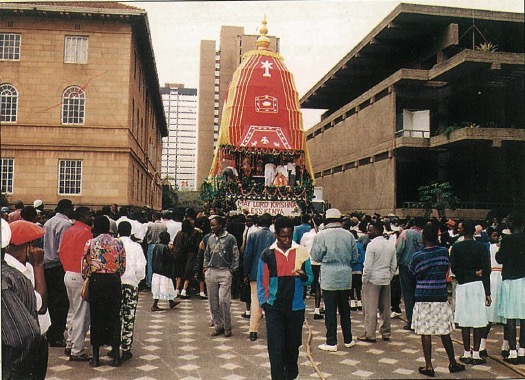By PRABHA PRABHAKAR BHARDWAJ
In August 8, 1997, a nationwide strike in Kenya by opposition leaders demanding constitutional reforms and the ousting of long-term president Daniel arap Moi turned violent. Policeman Gilbert Simiyu was beaten to death at a rally in support of the strike. Demonstrators–mostly unemployed youth–then rampaged through downtown Nairobi, the nation’s capital, smashing stores and stoning hotel windows. Two more people were killed. The following day was to be the yearly Rath Yatra in which the icons of Shri Krishna, Balaram and Subradhra were to be paraded through the city streets. But most of the Asian community, which is predominately Hindu, was hiding behind closed doors, and markets were shut. Most thought the event would–or should–be canceled. Asians–descendants of laborers brought to East Africa by the British a century ago to work on the railroads–number about 70,000 out of Kenya’s total population of 25 million.
Yet, as August 9 dawned, Krishna’s towering chariot prepared to leave on schedule from its home at ISKCON’s Sri Sri Radha Bankebihari Mandir. “Because of the events of August 8, people were very afraid, especially the Asian community,” temple chairman Swami Umapati Das told Hinduism Today. “I received many calls to postpone the Rath Yatra procession, and for a little while, I also became double-minded. But I contemplated and decided, the yatra is in the honor of God, who protects the whole world, so why should there be any fear? So, we carried out the plans undeterred.”
The parade started from the Kenyatta Conference Centre in central Nairobi, until recently the city’s tallest building. Only the swamis from the temple and 15 regular African devotees were there at the beginning. “We were very afraid,” confessed Swami Umapati das, “but there were no untoward incidents. In fact, it was more peaceful than usual–no stealing of personal articles like handbags, for example.” As the day went on, the crowd that followed the chariot kept growing as peace returned to the city. Men and women, children and grandparents, Africans, Asians and Europeans sang and danced through the streets in one rhythm to the “Hare Krishna” mantra. Sweets were distributed to 15,000 people along the route, while nearly 1,500 took a full meal at the temple complex upon completion of the Rath Yatra.
All 450 ISKCON temples worldwide observe the annual Rath Yatra festival, following the tradition of Jagannath Puri temple in Orissa, India, as instructed by ISKCON founder, A.C. Bhaktivedanta Prabhupada. The festival usually takes place near the beginning of August, with the date set by each temple for its local observance.


